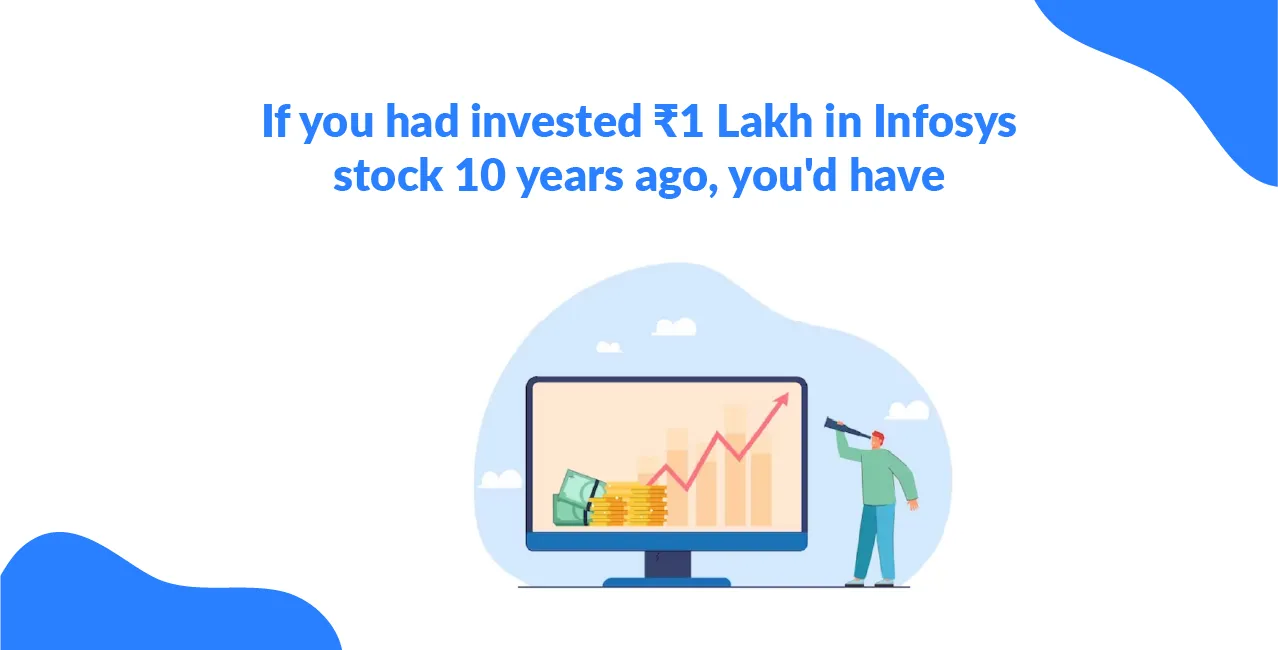
Author
LoansJagat Team
Read Time
5 Min
08 Jul 2025
If you had invested ₹1 Lakh in Infosys stock 10 years ago, you'd have...
Have you ever wished you had made a bold decision just 10 years ago? If yes, you're not alone.
Many regret not putting money in stocks that looked expensive back then but are now wealth machines. Infosys is one of them. You probably remember when a friend said, “Infosys is too costly,” and gave up on the idea. Today, that friend might be kicking himself.
Let’s break it down. Let's see how a ₹1,00,000 investment in Infosys in 2015 would have changed your life today. No fluff. Just numbers, logic, and the harsh truth most investors ignore.
Let’s first understand what happened in these 10 years
In April 2015, Infosys was trading around ₹220 per share (adjusted for splits and bonuses). Fast forward to April 2025, and the price climbed to roughly ₹590. This jump alone means an increase of around 168% in 10 years. That’s only the capital appreciation part.
Infosys also regularly pays dividends. The total value would have been higher if you had reinvested those payouts.
Here’s a simple table:
Now, let’s say you bought ₹1,00,000 worth of Infosys shares in 2015:
- You’d get around 454 shares (₹1,00,000 ÷ ₹220).
- As of 2025, those shares would be worth: 454 × ₹590 = ₹2,67,860
- Add average dividends of ₹15 per year for 10 years = ₹15 × 454 × 10 = ₹68,100
- Total = ₹2,67,860 + ₹68,100 = ₹3,35,960
That's more than 3× in 10 years. No mutual fund would give you this unless you chose very smartly.
So why did Infosys deliver this kind of wealth?
Infosys has done many things right. The company worked like a machine, from growing in digital services to maintaining high profit margins and staying debt-free.
Read More - How Much Would Your ₹10,000 Be Worth Today If You Had Invested It In Reliance Stock
Some reasons why Infosys became a strong wealth creator:
- Global clientele: Over 1,600 clients, including big Fortune 500 names.
- Employee efficiency: The revenue per employee stayed strong.
- Rupee depreciation: IT companies get more rupees when the dollar strengthens.
- Consistent payouts: Regular dividends built investor confidence.
And it’s not just for long-term holders. Infosys performs in cycles. You can also look at 3-year or 5-year rolling returns and still get 12% to 14% CAGR. That’s better than gold or FD.
Let’s add more numbers.
Comparison with other Indian stocks
Now, you might ask – okay, Infosys did well. But how does it stand against its peers?
Let’s see.
Infosys stayed consistent. No drama. No random jumps. Even in tough years like 2020 (Covid), Infosys gave decent returns.
Why do investors miss such chances?
There’s a reason why most people don't get rich from stocks. They get scared of market noise. When media screams "IT sector slowdown", they sell. When the price drops 10%, they panic.
But Infosys is a classic compounder. It grows slowly, but never goes out of fashion. That’s why smart investors like Rakesh Jhunjhunwala believed in IT long term.
A ₹1,00,000 investment sounds small. But if you had put ₹1,00,000 every year from 2015 to 2025 in Infosys, this is what it could look like:
Imagine the portfolio value after 10 years of such SIP-style investing.
Should you still buy Infosys now?
Let’s be honest. The best time to invest was 10 years ago. The second-best time is now, if you’re patient. Infosys will not give you 40% returns overnight. But if you stay for 5–7 years, even a 10–12% CAGR with dividends can beat FDs, gold, and real estate in many cases.
Plus, Infosys follows a stable dividend policy. You don’t just grow capital – you also earn passive cash every year.
It’s suitable for:
- Middle-class investors looking for long-term safety
- People wanting regular income (through dividends)
- New investors afraid of small-cap risk
Techniques to analyse stocks like Infosys
If you want to find more Infosys-like opportunities, here are 3 techniques:
- Fundamental Analysis: Look at PE ratio, ROE, margins, and debt-to-equity ratio.
- Dividend Analysis: A stock giving regular dividends shows strength.
- Consistent CAGR: Choose companies that maintain 10–12% CAGR across multiple time frames.
Infosys checks all three boxes. It doesn’t shock you with volatility. That’s why long-term investors love it.
Conclusion
Looking back, investing ₹1,00,000 in Infosys 10 years ago was not just a profitable move—it was a wealth-building decision that rewarded patience and belief in India’s tech story. Infosys proved that long-term investments in fundamentally strong companies can beat inflation, fixed deposits, and even many mutual funds.
It wasn’t a fluke or a lucky break. It was the result of steady growth, consistent dividends, and a strong global presence. While the past cannot be changed, the lesson is clear—start early, stay invested, and trust the process. You don’t need to chase risky stocks. You just need to stay consistent.
Also Read - The Ultimate Guide to Value Investing in 2025 – Warren Buffett’s Tips
FAQs
1. Is Infosys good for a 5-year investment?
Yes. If you don’t need money urgently and want steady growth plus dividends, Infosys is a strong choice.
2. How much dividend does Infosys pay yearly?
It depends on profit, but usually between ₹20 and ₹35 per share yearly.
3. Can I start SIP in Infosys stock?
Yes. You can manually invest monthly via demat account. Many investors do this instead of mutual funds.
4. What is the risk in Infosys shares?
IT slowdown or weak rupee can affect profits. But large companies like Infosys usually bounce back.
5. What is the minimum amount to invest in Infosys?
You can start with even one share. At ₹1,500–₹1,600 per share (2025 levels), it’s affordable for many.
Other Informative Pages | ||
How to Invest in Global Stocks from India: Step-by-Step Guide | ||
About the Author

LoansJagat Team
‘Simplify Finance for Everyone.’ This is the common goal of our team, as we try to explain any topic with relatable examples. From personal to business finance, managing EMIs to becoming debt-free, we do extensive research on each and every parameter, so you don’t have to. Scroll up and have a look at what 15+ years of experience in the BFSI sector looks like.

Quick Apply Loan
Subscribe Now


